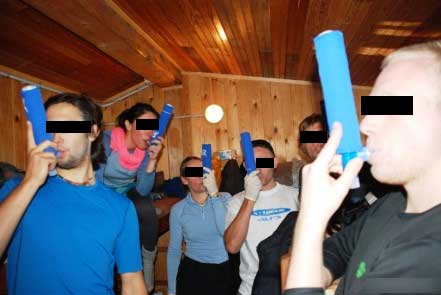DOLLARS AND SENSE
We get this question a lot. Dozens of EcoScreens are sitting in various facilities worldwide. The manufacturer no longer supports these, but it is natural to think of it as “free” since it is already there. On the surface, it makes no sense to spend more money on a collection system when you already have one sitting in the back room.
Or does it?
The short answer: it depends on what you want to study, how you want to study it, and the value you place on your people’s time.
The RTube and EcoScreen are both well-vetted in the literature. They are both good, but very different. The core advantage of the RTube is portability and the ability to go into the community and sample a large number of people easily and quickly. It has been used in schools to follow asthmatic children, on Mount Everest to test the effects of high altitude, and outside a Wal-Mart to collect condensate specimens on hundreds of people in one day.
You simply can not do this with an EcoScreen. Furthermore, only the RTube system allows for simultaneous collections in a group setting.
What makes the RTube so easy to deploy and simple to use? Ask our customers; the link below is for a video that one of our customers made to explain to their patients the EBC collection process and pH measurement:
SELECTING THE RIGHT COLLECTOR FOR YOUR STUDY
Perhaps you are considering a laboratory-based study where portability is less important. Other things to consider with your collector choice:
- RTube is disposable – No cleaning, no risk of infectious cross-contamination between patients. Guaranteed clean and safe with nearly 200,000 sold to researchers worldwide.
- The EcoScreen is reusable –The back of the check valve in the EcoScreen must be cleaned between patients to reduce the risk of infectious cross-contamination. The condensation chamber of the EcoScreen must also be cleaned between patients to avoid biomarker contamination which can affect your study results. Proper control of the cleaning process is vital to assuring a safe, non-contaminated device, and can be quite time-consuming. The quality of your biomarker data can be compromised by incomplete cleaning of the condensate chamber.
How about using a homemade device? Many have done this we believe to their detriment for two main reasons:
- Homemade devices can collect saliva – The classic homemade EBC collection device is a Teflon tube coiled inside a bucket of ice. The subject blows through one end and EBC is collected throughout the tube. Just about everybody unconsciously drools considerably during EBC collection. The RTube separates saliva from condensate and discharges it out the bottom of the device. Some of the EcoScreens have a small drain hole for saliva. Take a good look at your device and ask yourself where the saliva is going. Don’t trust the amylase test as a validation; its sensitivity is orders of magnitude less than the biomarker signatures you are looking for.
- Lack of Standardization – A study performed with a homemade device will likely not be exactly reproducible by another group. Furthermore, biomarker data obtained using a non-standard device is likely to be less credible to reviewers since it is difficult to bridge to other studies.
As you would expect, we strongly recommend the RTube for its reliable cleanliness and ease of use, both with the patient and in the lab. Also, we are here at your service whenever you need us. The EcoScreen, built by Filt which was bought by Jaeger which was bought by Viasys which was bought by Cardinal which became CareFusion has completely dropped the device and is no longer supporting it. Your local rep may still be able to help you, but many lack the technical expertise to offer meaningful guidance.
What should you do for technical support??
Do what many other EcoScreen owners have done: Contact Respiratory Research! We’ll be glad to help you no matter what collection device you use.
